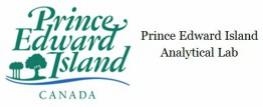The Why and How of Potato Tissue Testing
In recent years there have been steady advances in the technology of insect and disease control, tillage, and general crop management. Fertility management has also advanced considerably with concern focussed on micro nutrients as well as the traditional nitrogen, phosphorus and potash fertilizers. Plant tissue analysis has become a valuable tool in fertility management programs.
Tissue analysis does not replace, but rather compliments, soil testing. Soil testing can be used as a good "predictor" of fertilizer and lime needs before the crop is planted; whereas tissue testing is a good "barometer" of the success of the program. In some cases, nutritional disorders detected can be adjusted during the actual growing season; however, many times the tissue results are only useful in preventing a similar problem in future crops.
Plant Tissue Programs:
Generally, the amount and value of information obtained from tissue analysis will be directly related to the effort and attention put into the sampling. Tissue analysis is neither "foolproof" nor "all inclusive". Growers should not expect all their questions to be answered with a single tissue sample. Three general approaches that can be followed in tissue sampling programs are:
- Take tissue samples from an area when it shows unusual growth. This is a good way to diagnose problems but does not optimize the value of the testing program.
- Take a single set of tissue samples at the early bloom stage of growth. Traditionally, this has been the approach to tissue testing because more is known about the proper levels of nutrients at this growth stage.
- Begin to take a series of samples when flower buds start to form and continue until mid- August. Samples should be taken at least three times during the growing season.
The approach selected will depend on the amount of information required. The third approach should only be undertaken if a grower is using a fertilizer management program that can respond to subtle field-to-field differences in fertility requirements.
How to Take Samples
It is extremely important that tissue sampling be done properly. The reason being the level of nutrients in any plant may differ greatly with the age and portion of the plant. In the case of potatoes, the part of the plant that should be used for tissue analysis is the petiole. To have a consistent sampling technique, take a petiole from the same location on the plant each time the field is sampled. It is essential that the plant tissue not be contaminated with any foreign material, including soil.
If samples are not taken and handled properly, the results will be incorrect and may even result in recommendations that are harmful
Sampling Procedure
- Identify the area to be sampled. If a field has a "bad spot", it is important that a second sample be taken from a "normal" area in the same field for comparison purposes.
- Take note of the growth stage (bud, early bloom, full bloom, post bloom, etc.) and record this on the plant tissue form. Maximum nutrient information is achieved when samples are taken at the early bloom stage of growth.
- The part of the plant to be sampled is the uppermost petiole with a fully expanded leaf, usually the 4th from the top of the plant. Break the petiole from the main stem. Remove the first full matured leaf from the top of the plant (usually the 3rd or 4th leaf down). This can be cut off with a knife or broken off cleanly by hand.
- Sample from at least 20 different locations in the field. At each location take one petiole from 3 or 4 plants. A representative sample will have a minimum of 60-80 petioles. If you cannot avoid petioles with soil on them, RINSE briefly with clean water; do not wash them with soap or detergent and do not scrub them as the nutrient composition of the leaf can be altered. Try to avoid sampling fields within 3-5 days after being sprayed with pesticides or foliar nutrient solutions.
- Separate the leaflets from the petiole, and discard the leaflets. This can be done by picking the leaflets one by one from the petiole OR by holding the petiole in one hand, pinching the petiole at its base with the thumb and forefinger of the other hand and stripping the leaflets off the petiole. Individual leaflets must be removed from the petiole as quickly as possible. Snapping them off individually is the best method to use, but it is very time consuming. An alternative method where leaflets are removed from petioles is by grasping the base of the petiole with one hand and stripping the leaflets between the thumb and forefinger of the other hand. It may take a bit of practice but petioles can be stripped completely and quickly. This is very difficult to carry out if leaves are wilted.
- Place the petioles in a bag and label completely with name, field ID, sample date, and growth stage of the plant. At least 100g of petiole material (usually 60-80 petioles) is required by the lab.
- Keep samples in a cool dark place and transport to the lab for analysis as soon as possible.
Where do I deliver the samples?
PEI Analytical laboratories
Soil & Feed Testing Lab
23 Innovation Way
Charlottetown, PEI
C1E 0B7
Samples may also be left at your nearest Access PEI Locations
Plant Tissure Analysis Package
T4 Potato Petiole:
NO3-N, Ca, Mg, Cu, Zn, B, P, K
T4S Potato Petiole:
NO3-N, Ca, Mg, Cu, Zn, B, P, K, S
Note: Iron and Manganese are available as optional analysis but are done only on request as a deficiency or toxicity of these elements is unlikely on acidic PEI soils.
Expect the results to be complete in two to three working days.
